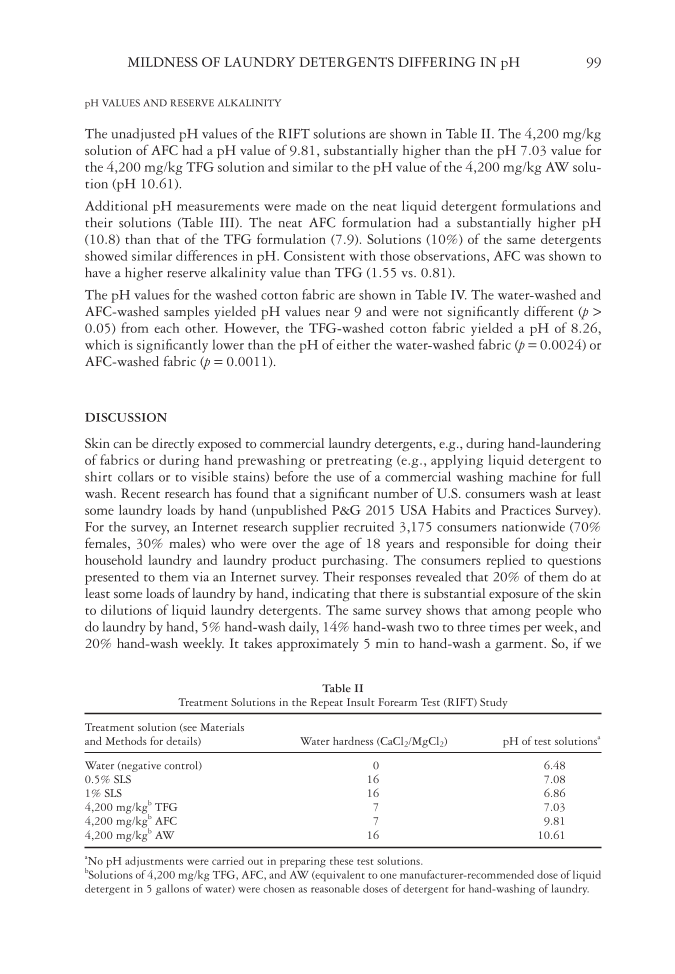MILDNESS OF LAUNDRY DETERGENTS DIFFERING IN pH 99 pH VALUES AND RESERVE ALKALINITY The unadjusted pH values of the RIFT solutions are shown in Table II. The 4,200 mg/kg solution of AFC had a pH value of 9.81, substantially higher than the pH 7.03 value for the 4,200 mg/kg TFG solution and similar to the pH value of the 4,200 mg/kg AW solu- tion (pH 10.61). Additional pH measurements were made on the neat liquid detergent formulations and their solutions (Table III). The neat AFC formulation had a substantially higher pH (10.8) than that of the TFG formulation (7.9). Solutions (10%) of the same detergents showed similar differences in pH. Consistent with those observations, AFC was shown to have a higher reserve alkalinity value than TFG (1.55 vs. 0.81). The pH values for the washed cotton fabric are shown in Table IV. The water-washed and AFC-washed samples yielded pH values near 9 and were not signifi cantly different (p 0.05) from each other. However, the TFG-washed cotton fabric yielded a pH of 8.26, which is signifi cantly lower than the pH of either the water-washed fabric (p = 0.0024) or AFC-washed fabric (p = 0.0011). DISCUSSION Skin can be directly exposed to commercial laundry detergents, e.g., during hand-laundering of fabrics or during hand prewashing or pretreating (e.g., applying liquid detergent to shirt collars or to visible stains) before the use of a commercial washing machine for full wash. Recent research has found that a signifi cant number of U.S. consumers wash at least some laundry loads by hand (unpublished P&G 2015 USA Habits and Practices Survey). For the survey, an Internet research supplier recruited 3,175 consumers nationwide (70% females, 30% males) who were over the age of 18 years and responsible for doing their household laundry and laundry product purchasing. The consumers replied to questions presented to them via an Internet survey. Their responses revealed that 20% of them do at least some loads of laundry by hand, indicating that there is substantial exposure of the skin to dilutions of liquid laundry detergents. The same survey shows that among people who do laundry by hand, 5% hand-wash daily, 14% hand-wash two to three times per week, and 20% hand-wash weekly. It takes approximately 5 min to hand-wash a garment. So, if we Ta ble II Treatment Solutions in the Repeat Insult Forearm Test (RIFT) Study Treatment solution (see Materials and Methods for details) Water hardness (CaCl2/MgCl2) pH of test solutionsa Water (negative control) 0 6.48 0.5% SLS 16 7.08 1% SLS 16 6.86 4,200 mg/kgb TFG 7 7.03 4,200 mg/kgb AFC 7 9.81 4,200 mg/kgb AW 16 10.61 a No pH adjustments were carried out in preparing these test solutions. b Solutions of 4,200 mg/kg TFG, AFC, and AW (equivalent to one manufacturer-recommended dose of liquid detergent in 5 gallons of water) were chosen as reasonable doses of detergent for hand-washing of laundry.
JOURNAL OF COSMETIC SCIENCE 100 conservatively assume that these respondents are only washing one garment at a time, expo- sure to diluted detergent can range between 5 and 35 min/week, at minimum. Therefore, the 15-min exposure times in the RIFT study are relevant to real-life exposures. This also reinforces that being aware of the potential consequences through mildness testing is a necessary part of the evaluation of commercial laundry detergents. This is particularly important considering the large and growing global population of people with sensitive skin. In the RIFT study reported here involving individuals with self-assessed sensitive skin, TFG was found to be signifi cantly milder than AFC by several measures, including corneometer and visual grading of dryness and erythema. In fact, by these same measures, TFG was either as mild as or even signifi cantly milder than water. And whereas erythema alone is often used as a measure of skin damage in surfactant stud- ies, a battery of measures such as hydration (25) and particularly skin surface pH (26–28) can be even more revealing with regard to mildness on sensitive skin. An important difference between TFG and AFC that might account at least in part for the mildness disparity between the two products in the RIFT study is the formulation pH. The pH of laundry detergents tends to be alkaline to improve cleaning performance and to avoid possible damage to fabrics from acidic conditions (19,29,30). Yet, the pH of AFC is particularly high (10.8), nearly 3 units higher than the pH of TFG (7.9). In some studies, exposure of the skin to solutions with a high pH was shown to induce physiological changes such as irritation, stratum corneum swelling, alterations in stra- tum corneum proteins and lipids, and barrier damage (31–34). These effects appear to be more pronounced as the pH approaches or exceeds 10. The measurements carried out here indicate that even a low concentration of AFC has a pH of nearly 10. The negative effects Table IV pH of Washed Cotton Fabric Fabric washing treatmenta pH of washed cotton fabric extracted with water Water 9.00 AFC 9.22 TFG 8.26 a Fabric is 5 g of 100% cotton T-shirt washed three times in a HE washing machine with the indicated treat- ment (water, TFG, or AFC liquid detergent) and then extracted with 50 mL of water for 2 h. Table III Liquid Detergent Solution pH Values and Residual Alkalinity Solutiona pH Reserve alkalinity (%)b TFG 7.9 — 10% TFG 8.2 0.81 AFC 10.8 — 10% AFC 11.0 1.55 a Ten percent or higher solutions of liquid detergent are typically used by consumers for hand-washing of fabric or for hand-prewashing of fabric before use of a commercial washing machine. b The amount (expressed as %) of 0.2 N HCl required to titrate the solution down to pH 5.5, the approximate pH of the skin surface. Reserve alkalinity was only determined on the 10% dilution, the approximate con- centration expected in a hand-fabric-prewash situation.
Purchased for the exclusive use of nofirst nolast (unknown) From: SCC Media Library & Resource Center (library.scconline.org)

















































